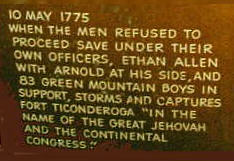 |
ETHAN ALLEN'S ROUTE TO Marker from |
 |
ETHAN ALLEN'S ROUTE TO Marker from |

In the early morning hours of May 10, 1775, the patriot forces consisting of :
reached the east side of Lake Champlain near Fort Ticonderoga. But due to a
shortage of crossing space, only about 100 men advanced on the fort, less than half of their small army. The boats that
were suppose to be captured from Skenesboro (Whitehall, New York)
had never arrived. The patriot forces marched on the fort which was being
defended by a small
British company of about twenty men under the command of Captain Delaplace.
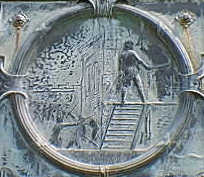 |
Dedicated to memory of the gallant band of patriots let by Ethan Allen who on the 10th of May, 1775 captured this important fortress, secured for the Americans a valuable base of operations on Lake George and Champlain. Erected by the Sons of the Revolution in the State of New York, MDCCCC. |
They marched in columns, three abreast. A sentry on
guard at the entrance attempted to fire at the intruders, but his gun misfired.  The
Americans stormed into the fort and Ethan Allen demanded surrender. When Captain
Delaplace asked under whose authority, Allen screamed: "the Great Jehovah
and the Continental Congress". Delaplace surrendered and Ethan Allen and
the Green Mountain Boys had taken the fort without firing a shot.
The
Americans stormed into the fort and Ethan Allen demanded surrender. When Captain
Delaplace asked under whose authority, Allen screamed: "the Great Jehovah
and the Continental Congress". Delaplace surrendered and Ethan Allen and
the Green Mountain Boys had taken the fort without firing a shot.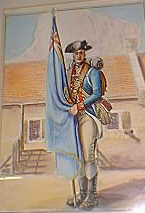
"The sun seemed to rise that morning with a superior luster and Ticonderoga and its dependencies smiled on its conquerors who tossed about the flowing bowl and wished success to Congress and the liberty and freedom of America", Ethan Allen, May 10, 1775.
The surrender of Fort Ticonderoga marked the first overt military action by Americans against the British in their quest for American independence. It was no doubt a daring and courageous act.
Later that year, General Henry Knox would begin moving cannon from Fort Ticonderoga to Boston. The same marker that appears on the Carillon Battlefield and at many other locations along the route that General Knox took also appears in the Place d'Arms at the center of the fort.
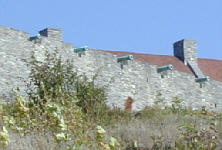
In October of 1776, the British, led by Sir Guy Carleton, marched
against the Americans at Fort Ticonderoga. Under the command of General Horatio
Gates and the support and leadership of Philip Schuyler, the Americans were well
dug-in and prepared for the British. After scouting the area and observing the
impressive state of readiness at both Ticonderoga and Mount Independence, the
British changed their mind. With winter coming and not enough time to mount a
major and timely offensive, the British retreated back to Canada. They would
have arrived earlier, but they were delayed by Benedict Arnold's annoying
American Navy on Lake Champlain. So, after just a few minor skirmishes, the two
armies disengaged until next year.
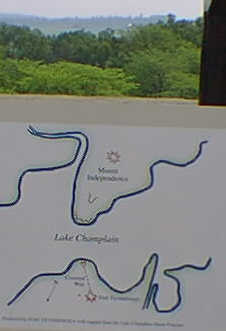 |
Fort Ticonderoga (Carillion) successfully commanded the two waterways from the south but its position atop this ridge left the far side of the peninsula unprotected by cannon batteries. Army engineers in charge of the construction of the French Fort Carillion built an additional battery on the cliff at the end of the point to protect two landing sights, a shallow landing for bateau and cannons to the right and a cargo landing on the point to the north left where supply ships would tie up and unload. A covered way dug to the height of a man connected the fort to the battery. |
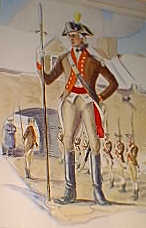 In
1777, the British, led this time by General John Burgoyne, arrived plenty early
enough on July 2nd and the American fortifications were not nearly as
impressive. George Washington had turned his attention to Pennsylvania and did
not expect the British to launch another major offensive against Fort
Ticonderoga. So, this time it was the Americans who were not ready for a major
offensive.
In
1777, the British, led this time by General John Burgoyne, arrived plenty early
enough on July 2nd and the American fortifications were not nearly as
impressive. George Washington had turned his attention to Pennsylvania and did
not expect the British to launch another major offensive against Fort
Ticonderoga. So, this time it was the Americans who were not ready for a major
offensive.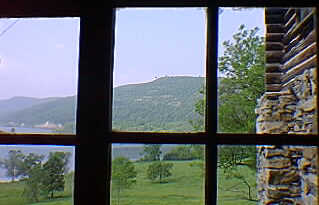
On July 4, 1777, British forces were observed moving artillery up the side of Mount Defiance, an action that the Americans had not considered possible and, for which, were totally unprepared. From Mount Defiance, the defenses of both Fort Ticonderoga and Mount Independence were considered relatively easy targets. So, it was decided in a council of war on July 5th that General Arthur St. Clair would lead the Americans in retreat under the cover of darkness down the military road to Castleton. When the British discovered the American retreat, Burgoyne sent a detachment to pursue the Americans, but they were stopped at Hubbardton.
 |
Colonel John Brown
of Killed October 19, 1780 at Stone Arabia, New York on his 35th birthday. Was with Ethan Allen, May 10, 1775. Made a gallant attempt to retake the fort, September 17-22, 1777, but failed owing to the sturdy defense of Brigadier General Henry W. Powell. Colonel Brown destroyed the shipping and outer works, captured 225 British and Germans and released 100 American prisoners. This tablet was
erected by the Massachusetts Society of the Colonial Dames of America,
1935. |
 Burgoyne
continued down Lake Champlain toward Albany leaving behind a detachment of
about 200 men at Fort Ticonderoga. In September of 1777, Americans marched
back to Fort Ticonderoga under the command of Colonel John Brown (yes, the
same John Brown who helped plan the capture of Ticonderoga in 1775 in
Pittsfield). Despite outnumbering the British five-to-one and essentially
surrounding the fort and even targeting Fort Ticonderoga with Cannon from the
top of Mount Defiance, the British forces did not retreat or surrender. The
Americans had no desire to storm the walls of Fort Ticonderoga nor did it make
any sense to do so. As a result, the British held Fort Ticonderoga until the
end of the war, but in many ways, the fort became their own self-imposed
prison.
Burgoyne
continued down Lake Champlain toward Albany leaving behind a detachment of
about 200 men at Fort Ticonderoga. In September of 1777, Americans marched
back to Fort Ticonderoga under the command of Colonel John Brown (yes, the
same John Brown who helped plan the capture of Ticonderoga in 1775 in
Pittsfield). Despite outnumbering the British five-to-one and essentially
surrounding the fort and even targeting Fort Ticonderoga with Cannon from the
top of Mount Defiance, the British forces did not retreat or surrender. The
Americans had no desire to storm the walls of Fort Ticonderoga nor did it make
any sense to do so. As a result, the British held Fort Ticonderoga until the
end of the war, but in many ways, the fort became their own self-imposed
prison.
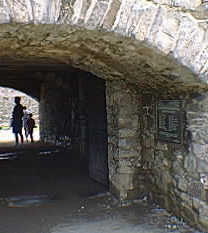 |
1776-1929 Through this
entrance to the |
|
|
George Washington |
Richard Montgomery and a host of other great men of our history. |
|
|
Ye who tread in their footsteps, |
||